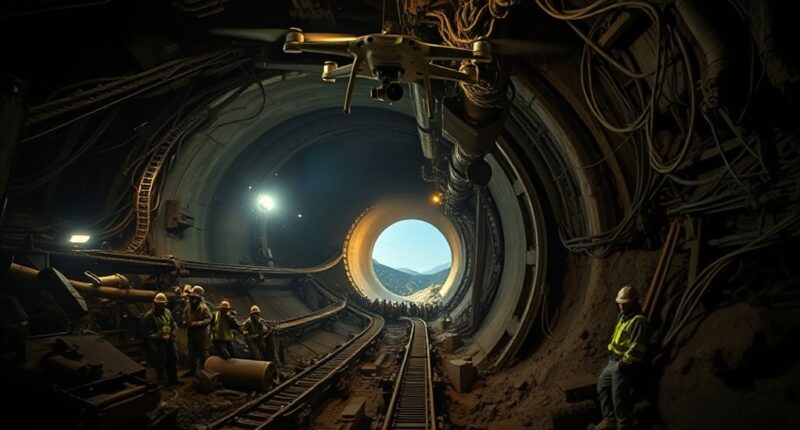As regulatory crackdowns tighten worldwide, miners are shifting operations to regions with more welcoming policies, such as parts of Africa, Central Asia, and certain Southeast Asian countries. These areas often offer less restrictive licensing, more favorable environmental standards, and lower compliance costs. To stay ahead, it’s crucial to understand where these moves are happening and the factors driving them. If you want to discover the latest hotspots and strategy tips, keep exploring these evolving industry shifts.
Key Takeaways
- Miners are shifting to countries with more favorable, less restrictive regulatory environments to avoid compliance hurdles.
- Emerging jurisdictions with clearer environmental policies attract investments from companies seeking regulatory stability.
- Countries adopting international standards and greener policies become new hotspots for sustainable mining operations.
- Regions with recent regulatory crackdowns are prompting miners to explore alternative locations with fewer restrictions.
- Strategic moves include relocating to jurisdictions offering incentives, streamlined licensing, and supportive government policies.

Regulatory crackdowns are intensifying worldwide as governments seek to control emerging risks and enforce compliance. These measures are often driven by concerns over environmental impact, as authorities become increasingly aware of the ecological damage caused by certain industries, particularly mining. When governments implement stricter regulations, they aim to reduce carbon emissions, limit pollution, and conserve natural resources. You’ll need to stay alert to shifting legal landscapes, as new policies can make previously profitable ventures unviable or force you to adopt costly sustainable practices. Many countries are now prioritizing environmental considerations, pushing for greener mining techniques and stricter waste management, which can considerably impact your bottom line.
As governments tighten their policies, they often introduce measures such as stricter environmental impact assessments, licensing restrictions, or limits on resource extraction. These policies are designed to safeguard ecosystems but can create hurdles for miners. You might find yourself needing to invest heavily in cleaner technologies, or face delays and increased costs due to compliance requirements. If you’re considering expanding operations or moving into new jurisdictions, understanding these policies becomes critical. Countries with aggressive environmental policies might offer incentives for sustainable practices, but they also demand higher standards that require substantial upfront investments. Conversely, some regions may impose outright bans or moratoriums on certain types of mining activities, pushing you to seek alternative locations that offer more favorable regulatory environments.
The ongoing global focus on environmental impact is also prompting governments to collaborate on international standards and agreements. You’ll need to stay informed about global initiatives that could influence national policies, such as climate accords or biodiversity treaties. These agreements can lead to tighter regulations and compliance obligations, making it essential for your operations to adapt swiftly. Non-compliance not only risks legal penalties but can also damage your reputation and stakeholder trust. Therefore, proactive engagement with policymakers and investment in sustainable practices are becoming more than just good ethics; they’re essential for survival in this evolving regulatory landscape.
In this climate, your best strategy is to prioritize transparency and sustainability, aligning your projects with government policies that favor responsible mining. Doing so can help you gain a competitive edge, access incentives, and avoid costly legal battles. As regulations grow stricter, the companies that adapt quickly and incorporate environmental considerations into their core operations will be the ones that thrive in the long term. The shift isn’t just about compliance; it’s about shaping a sustainable future for mining while maintaining your profitability and reputation. Staying informed about regulatory changes and adopting environmentally friendly techniques are key to ensuring your operations’ resilience and success.
Frequently Asked Questions
Which Countries Are Most Attractive for Crypto Miners Now?
You should consider countries offering strong mining incentives and favorable tax policies. Places like the US, Canada, and certain European nations attract miners with their supportive regulations and affordable electricity. These regions provide a stable environment where you can maximize profitability. Look for locations that balance low operational costs with clear, friendly policies, helping you stay competitive and compliant as you expand your mining operations in the current global landscape.
How Do Regulatory Changes Impact Global Cryptocurrency Prices?
Regulatory changes can substantially impact your investments by increasing market volatility and shifting investor sentiment. When governments tighten rules, prices often dip as confidence wanes, but they can also rebound if regulations create clarity. You should stay alert to policy shifts because they influence market dynamics, affecting how you perceive risk and opportunity. Ultimately, understanding regulatory impacts helps you make smarter, more informed decisions in the volatile crypto landscape.
What Are the Environmental Concerns Linked to Mining Relocations?
You should know that mining relocations raise significant environmental impact concerns, especially regarding energy consumption and carbon emissions. Miners often move to regions with cheaper electricity, but if that energy isn’t renewable, it worsens climate change. Supporting renewable energy sources can reduce these environmental impacts, making mining more sustainable. It’s essential to promote clean energy adoption to minimize ecological damage caused by these relocations.
Are There Legal Risks for Miners Moving to New Jurisdictions?
You face legal risks when moving to new jurisdictions due to regulatory uncertainty. Facilitating legal compliance becomes vital, as differing laws and regulations can lead to fines or shutdowns if ignored. You need to thoroughly research local regulations, obtain necessary permits, and stay updated on policy changes. Managing these risks proactively helps you avoid legal complications and guarantees a smoother transition for your mining operations in the new location.
How Do Regulatory Crackdowns Influence Blockchain Innovation?
You’ll find that regulatory crackdowns can both hinder and motivate blockchain innovation. When authorities enforce strict compliance, it pushes developers to focus on regulatory compliance and create more secure, compliant solutions. Conversely, these crackdowns can reduce innovation incentives, making it harder for new ideas to flourish. Overall, regulation influences how freely you can experiment and innovate within the blockchain space, shaping its future growth and development.
Conclusion
As you navigate the evolving landscape of crypto mining, staying adaptable is key. With regulators tightening their grip in some regions, you’ll need to keep an eye on emerging markets offering friendly policies. Moving your operations isn’t easy, but it can open new opportunities and help you stay compliant. By staying informed and flexible, you assure your mining ventures remain resilient, no matter where regulations head next. Keep monitoring global trends to stay ahead of the game.









